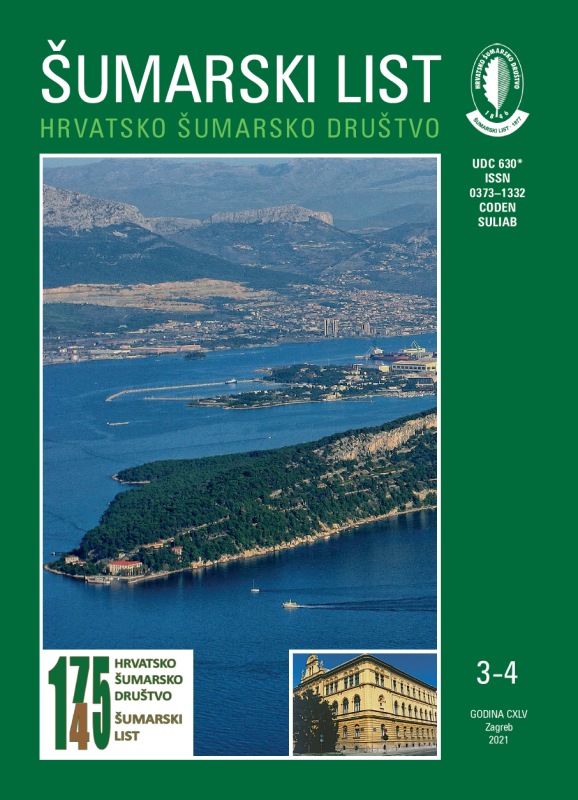
broj: 3-4/2021
pdf (11,5 MB) |
|
||||||||||||||
| RIJEČ UREDNIŠTVA | ||
| Uredništvo | ||
| Misunderstanding pdf HR EN | 113 | |
| IZVORNI ZNANSTVENI ČLANCI | ||
| Dino Hadžidervišagić, Azra Čabaravdić | UDK 630* 272 (001) https://doi.org/10.31298/sl.145.3-4.1 | |
| Importance and structural diversity of trees in a historical park pdf HR EN | 117 | |
| Dušan Jovanović, Milan Gavrilović, Mirko Borisov, Miro Govedarica | UDK 630*902 (001) https://doi.org/10.31298/sl.145.3-4.2 | |
| Deforestation monitoring with Sentinel 1 and Sentinel 2 images – the case study of Fruška gora (Serbia) pdf HR EN | 127 | |
| PRETHODNO PRIOPĆENJE | ||
| Boris Miklić, Anja Žmegač, Domagoj Trlin , Marko Orešković, Stjepan Mikac, Igor Anić | UDK 630* 111.8 https://doi.org/10.31298/sl.145.3-4.3 | |
| Climate sensitivity of black pine (Pinus nigra Arnold.) chronology in the Northern Velebit pdf HR EN | 137 | |
| Jelena Kranjec Orlović, Ida Bulovec, Milivoj Franjević, Damjan Franjević, Josip Skejo, Marin Biliškov, Danko Diminić, Boris Hrašovec | UDK 630*232.3 + 442 https://doi.org/10.31298/sl.145.3-4.4 | |
| Preliminary results on narrow-leaved ash (Fraxinus angustifolia Vahl) and green ash (Fraxinus pennsylvanica Marshall) seed entomofauna in Croatia pdf HR EN | 147 | |
| Mirjana Stevanov, Albina Tarjan Tobolka, Ljubomir Kljajić, Martina Kičić, Max Krott | UDK 630*903 https://doi.org/10.31298/sl.145.3-4.5 | |
| Analysis of conflicing interests on the example of the special nature reserve in Serbia: empirically analytical approach pdf HR EN | 155 | |
| Erol Akkuzu, Mustafa Şahin, Abdullah Ugiş, Ebru Bal | UDK 630* 453 https://doi.org/10.31298/sl.145.3-4.6 | |
| Assesment of trap color and trap height above the ground on the capture of Ips sexdentatus and Thanasimus formicarius pdf HR EN | 169 | |
| Summary The six-toothed pine bark beetle Ips sexdentatus is one of the most devastating bark beetles of Eurasian pine forests. Pheromone traps are used to monitor and control Ips sexdentatus populations. In this study, the effect of trap color and trap height on the capture of Ips exdentatus and its predator the ant beetle Thanasimus formicarius was investigated. The research was conducted in Pinus sylvestris stands within Yayla Forest Enterprise Chief (Kastamonu-Daday) in Turkey. In the study area, 25 Scandinavian type three-funnel traps of 5 different colors (yellow, white, green, black, and red traps with five replications) were used. Traps were placed at the same height, 1.5 m above ground. For the second part of the study, a total of 20 traps (5 per height category) was placed 1.0 m, 1.5 m, 2.0 m, and 2.5 m above ground. Traps were controlled at intervals of 7-10 days and captured Ips exdentatus and Thanasimus formicarius were counted. The results of the study were as follows: 1) Significant differences in the number of captures by trap color, and 2) No significant differences in the numbers of Ips sexdentatus and Thanasimus formicarius captured between the trap heights. Key words: six-toothed pine bark beetle; ant beetle; trap height; trap color; pine | ||
| PREGLEDNI ČLANCI | ||
| Damir Barčić, Vlado Habjanec, Željko Španjol, Mario Šango | UDK 630* 111.5 + 421 https://doi.org/10.31298/sl.145.3-4.7 | |
| Analysis of raising windbreaks on the mediterranean karst of Croatia pdf HR EN | 175 | |


